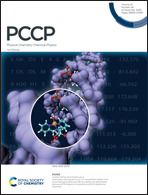Bottom-up derived flexible water model with dipole and quadrupole moments for coarse-grained molecular simulations†
Abstract
Coarse-grained water models offer opportunities to study the molecular processes in water on spatial and temporal scales inaccessible to conventional atomic-level simulations. Such a model that can accurately describe the structural, electrostatic and thermodynamic properties of liquid water is difficult to derive but invaluable. Here, we present FlexDQ, a flexible three-site coarse-grained model, representing clusters of water molecules. This model was derived using a full bottom-up approach in which atomistic information of water molecules is processed using clustering techniques based on considerations of both energy and geometry and a mapping algorithm that encodes information of dipole and quadrupole moments of water clusters into coarsely grained interaction sites. Parameterization of FlexDQ was conducted consistently and systematically, augmented by these data. The resulting model reproduces not only dipolar and quadrupolar fluctuations of water clusters, but also their local structural correlations in the bulk phase and, to a good extent, pressure-related properties, dielectric permittivity and water–air interfacial properties that were not targeted for parameterization. The ability of our model to reproduce various properties of water has been shown to originate from its explicit treatment of electrostatics. Coupled with the popular MARTINI CG model, FlexDQ captures the entropy–enthalpy balance of hydrophobic interactions and describes the dielectric behavior of water at the water–membrane interface, yielding a positive internal electrostatic potential in membranes, which is otherwise difficult to reproduce using MARTINI alone. Together, the FlexDQ model and its development framework reported here show promise for studies on the biomolecules in water.



 Please wait while we load your content...
Please wait while we load your content...